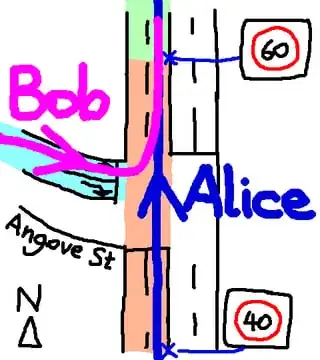This is a follow-up question for "Ambiguous speed limit after passing a T-junction" (59728). The original question asks what the speed limit is, in the 20 metres after the intersection and before the 60-sign. This question asks whether ignorance of this speed limit is a valid defence.
We again consider the intersection between Fitzgerald St and Angove St in North Perth, Western Australia (left-hand traffic). This is a T-junction, with Fitzgerald St being the continuing road and Angove St being the terminating road.
Dale M's answer to the original question establishes that:
- The speed limit along Fitzgerald St northbound is 40 km/h (pink), beginning at the 40-sign before the intersection, all the way up to the 60-sign erected 20 metres after the intersection. Only after this 60-sign does the speed limit become 60 km/h (green).
- The existence of a side road with a 50 km/h limit (blue) is irrelevant.
Now suppose that Bob approaches on Angove St and turns left into Fitzgerald St northbound. Bob knows nothing about the earlier 40-sign, but sees only the 60-sign, and concludes either:
- The speed limit on Fitzgerald St is immediately 60 km/h, since the 60-sign is consistent with all of Fitzgerald St being a 60-zone (which was indeed the case before 2016); or
- The speed limit on Fitzgerald St is immediately 50 km/h, since the 20 metres up to the 60-sign is an unsigned portion of a built-up area.
Therefore, after completing the left turn, Bob drives through the final 20 metres of the 40-zone believing that it is either a 60-zone or a 50-zone. (Yes this is difficult, but I think just doable with a powerful car by starting with a wide left turn into right lane at 35 km/h.)
Does Bob have a valid defence if issued with a speeding infringement?
If yes, suppose that Alice drives along Fitzgerald St northbound, straight through the intersection, clocking a speed of 60 km/h within the final 20 metres of the 40-zone.
Would infringing Alice require proving that she did not turn left from Angove St like Bob did?

